Healthcare Case Study Report: Analyzing Adam's Context and Needs
VerifiedAdded on 2023/01/17
|9
|2225
|96
Report
AI Summary
This report presents a comprehensive analysis of a healthcare case study focusing on a young individual named Adam, who is in OOHC. The report examines Adam's background, including his family relationships (or lack thereof), substance abuse, and social interactions. It explores how Adam's context influences strategies for working with him, emphasizing empathy, building trust, and encouraging social engagement. The report details initial meeting strategies, including open-ended questions and relatable sharing. It also proposes long-term interventions, such as education, constructive hobbies, and spiritual activities. Furthermore, it outlines responses to potential incidents, including violence, and addresses ethical considerations related to family interactions, particularly Adam's relationship with his father, referencing relevant laws and ethical principles like beneficence and utilitarianism. The report concludes with a list of references supporting the analysis and proposed interventions.
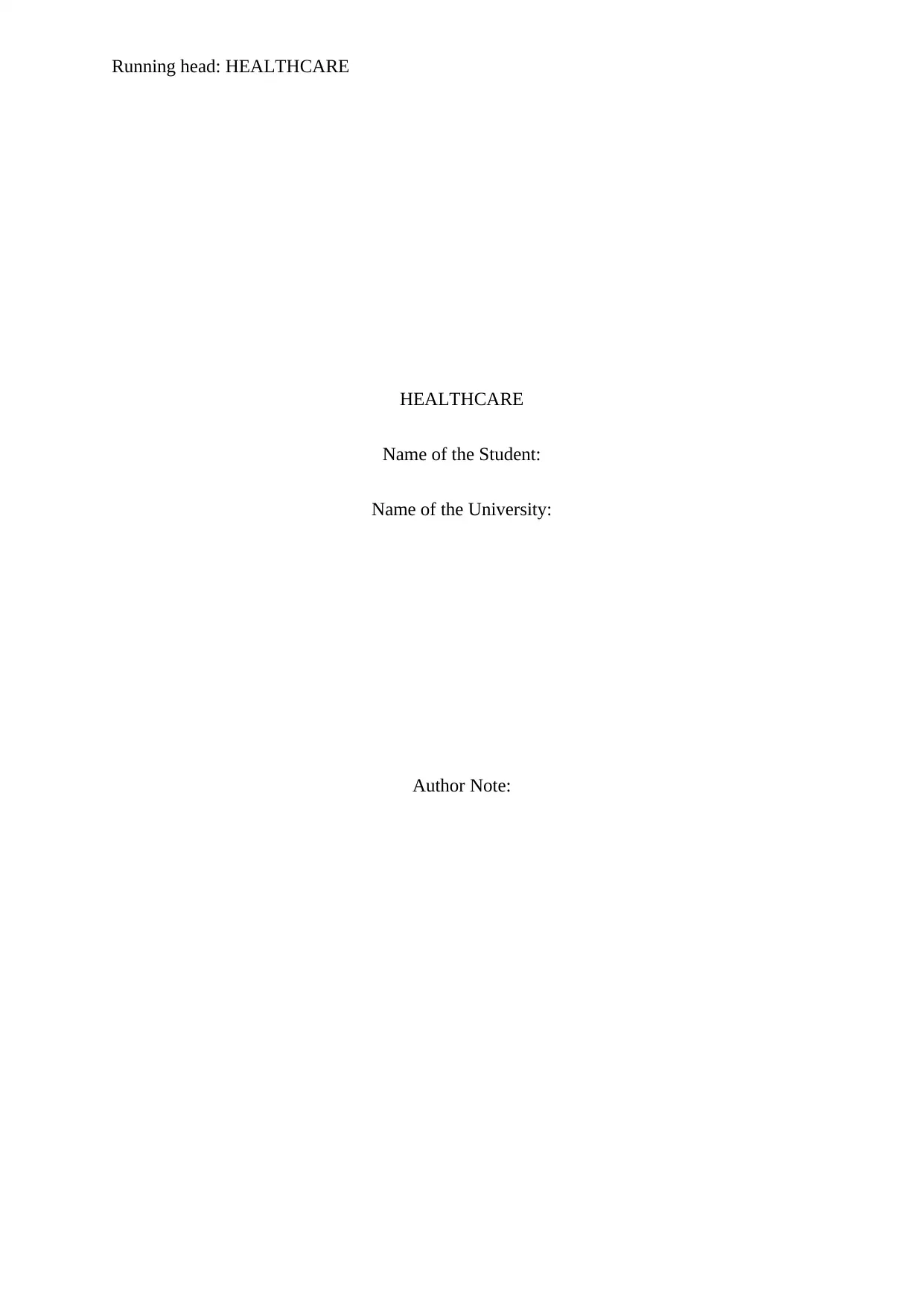
Running head: HEALTHCARE
HEALTHCARE
Name of the Student:
Name of the University:
Author Note:
HEALTHCARE
Name of the Student:
Name of the University:
Author Note:
Paraphrase This Document
Need a fresh take? Get an instant paraphrase of this document with our AI Paraphraser
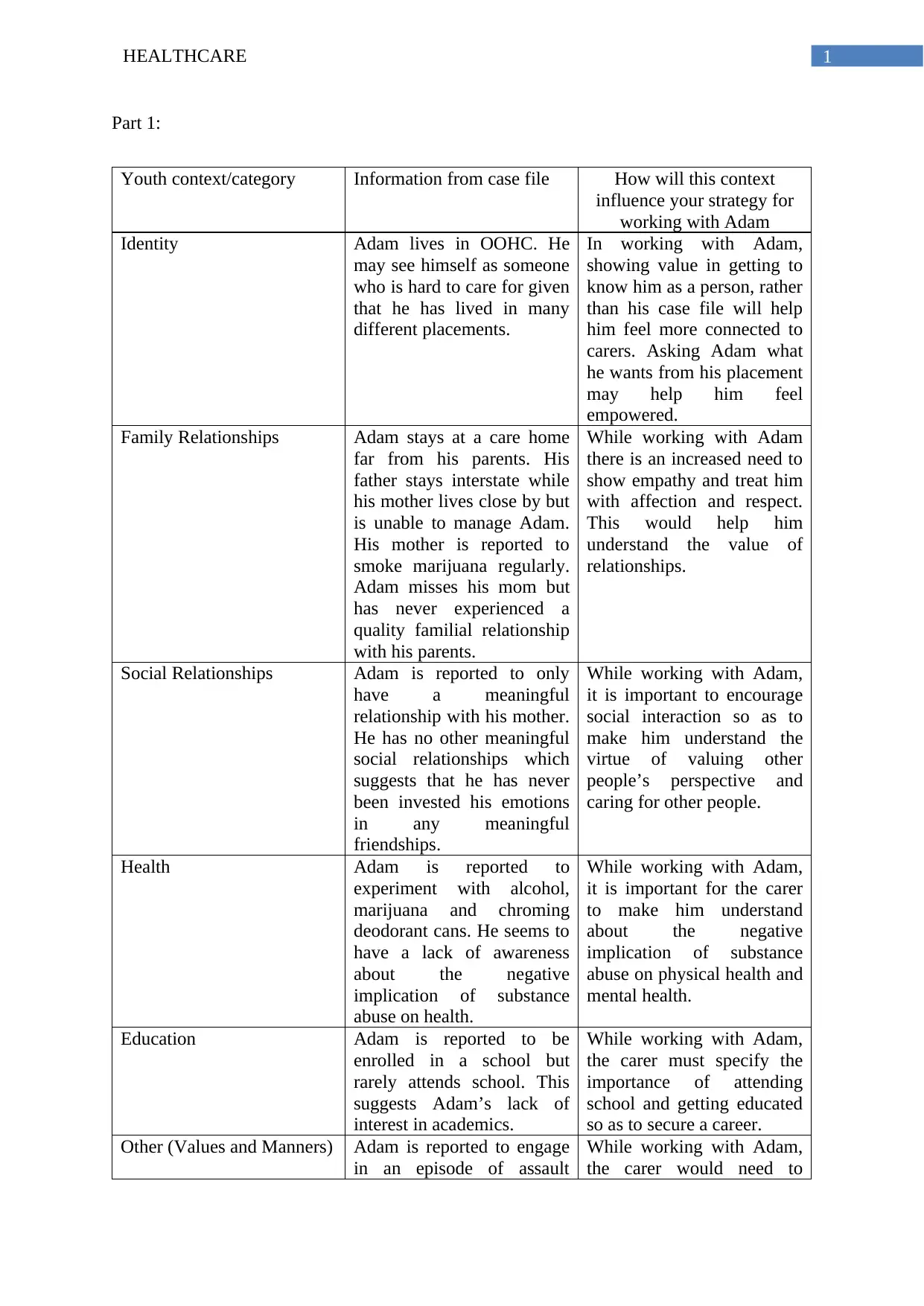
1HEALTHCARE
Part 1:
Youth context/category Information from case file How will this context
influence your strategy for
working with Adam
Identity Adam lives in OOHC. He
may see himself as someone
who is hard to care for given
that he has lived in many
different placements.
In working with Adam,
showing value in getting to
know him as a person, rather
than his case file will help
him feel more connected to
carers. Asking Adam what
he wants from his placement
may help him feel
empowered.
Family Relationships Adam stays at a care home
far from his parents. His
father stays interstate while
his mother lives close by but
is unable to manage Adam.
His mother is reported to
smoke marijuana regularly.
Adam misses his mom but
has never experienced a
quality familial relationship
with his parents.
While working with Adam
there is an increased need to
show empathy and treat him
with affection and respect.
This would help him
understand the value of
relationships.
Social Relationships Adam is reported to only
have a meaningful
relationship with his mother.
He has no other meaningful
social relationships which
suggests that he has never
been invested his emotions
in any meaningful
friendships.
While working with Adam,
it is important to encourage
social interaction so as to
make him understand the
virtue of valuing other
people’s perspective and
caring for other people.
Health Adam is reported to
experiment with alcohol,
marijuana and chroming
deodorant cans. He seems to
have a lack of awareness
about the negative
implication of substance
abuse on health.
While working with Adam,
it is important for the carer
to make him understand
about the negative
implication of substance
abuse on physical health and
mental health.
Education Adam is reported to be
enrolled in a school but
rarely attends school. This
suggests Adam’s lack of
interest in academics.
While working with Adam,
the carer must specify the
importance of attending
school and getting educated
so as to secure a career.
Other (Values and Manners) Adam is reported to engage
in an episode of assault
While working with Adam,
the carer would need to
Part 1:
Youth context/category Information from case file How will this context
influence your strategy for
working with Adam
Identity Adam lives in OOHC. He
may see himself as someone
who is hard to care for given
that he has lived in many
different placements.
In working with Adam,
showing value in getting to
know him as a person, rather
than his case file will help
him feel more connected to
carers. Asking Adam what
he wants from his placement
may help him feel
empowered.
Family Relationships Adam stays at a care home
far from his parents. His
father stays interstate while
his mother lives close by but
is unable to manage Adam.
His mother is reported to
smoke marijuana regularly.
Adam misses his mom but
has never experienced a
quality familial relationship
with his parents.
While working with Adam
there is an increased need to
show empathy and treat him
with affection and respect.
This would help him
understand the value of
relationships.
Social Relationships Adam is reported to only
have a meaningful
relationship with his mother.
He has no other meaningful
social relationships which
suggests that he has never
been invested his emotions
in any meaningful
friendships.
While working with Adam,
it is important to encourage
social interaction so as to
make him understand the
virtue of valuing other
people’s perspective and
caring for other people.
Health Adam is reported to
experiment with alcohol,
marijuana and chroming
deodorant cans. He seems to
have a lack of awareness
about the negative
implication of substance
abuse on health.
While working with Adam,
it is important for the carer
to make him understand
about the negative
implication of substance
abuse on physical health and
mental health.
Education Adam is reported to be
enrolled in a school but
rarely attends school. This
suggests Adam’s lack of
interest in academics.
While working with Adam,
the carer must specify the
importance of attending
school and getting educated
so as to secure a career.
Other (Values and Manners) Adam is reported to engage
in an episode of assault
While working with Adam,
the carer would need to
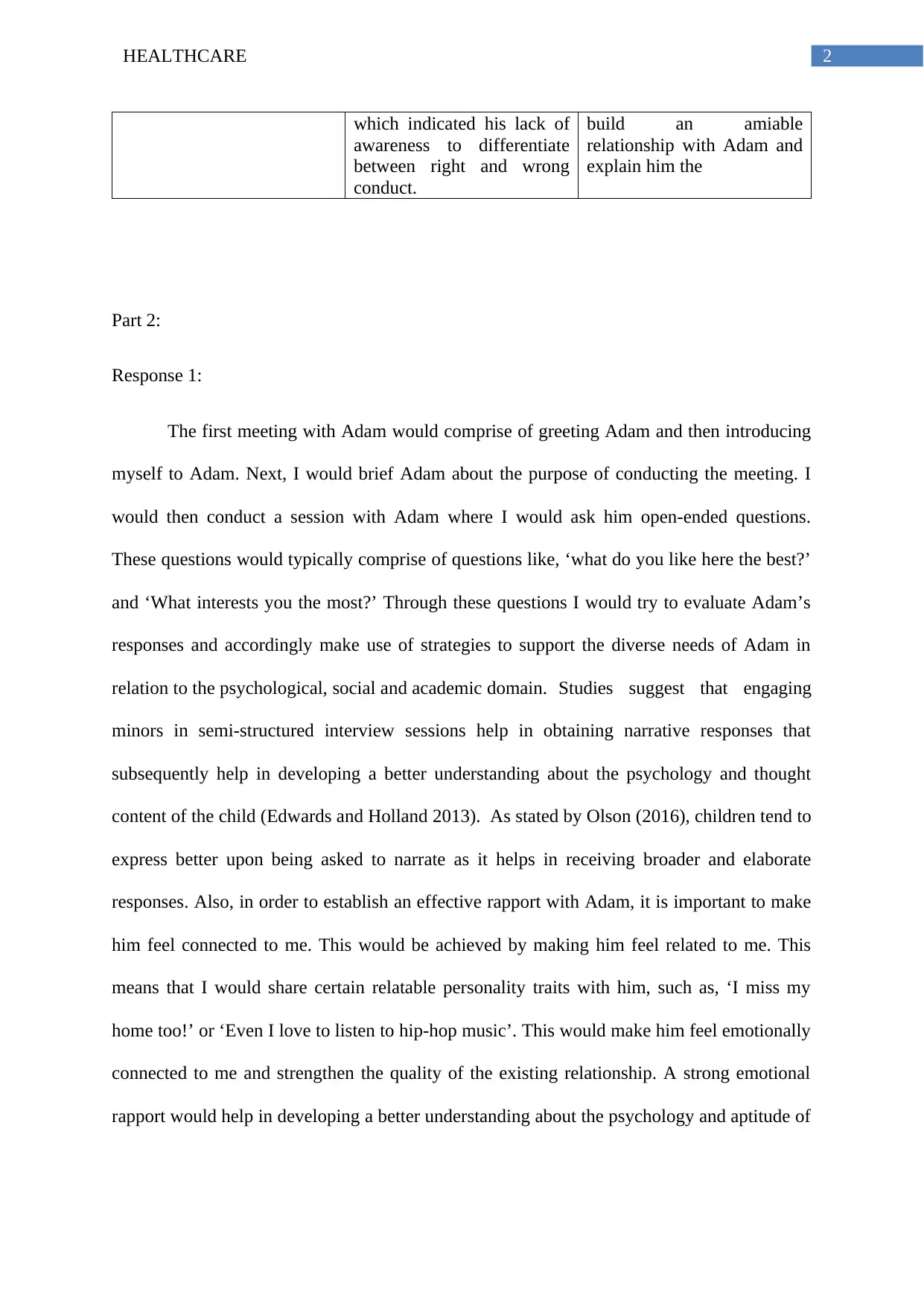
2HEALTHCARE
which indicated his lack of
awareness to differentiate
between right and wrong
conduct.
build an amiable
relationship with Adam and
explain him the
Part 2:
Response 1:
The first meeting with Adam would comprise of greeting Adam and then introducing
myself to Adam. Next, I would brief Adam about the purpose of conducting the meeting. I
would then conduct a session with Adam where I would ask him open-ended questions.
These questions would typically comprise of questions like, ‘what do you like here the best?’
and ‘What interests you the most?’ Through these questions I would try to evaluate Adam’s
responses and accordingly make use of strategies to support the diverse needs of Adam in
relation to the psychological, social and academic domain. Studies suggest that engaging
minors in semi-structured interview sessions help in obtaining narrative responses that
subsequently help in developing a better understanding about the psychology and thought
content of the child (Edwards and Holland 2013). As stated by Olson (2016), children tend to
express better upon being asked to narrate as it helps in receiving broader and elaborate
responses. Also, in order to establish an effective rapport with Adam, it is important to make
him feel connected to me. This would be achieved by making him feel related to me. This
means that I would share certain relatable personality traits with him, such as, ‘I miss my
home too!’ or ‘Even I love to listen to hip-hop music’. This would make him feel emotionally
connected to me and strengthen the quality of the existing relationship. A strong emotional
rapport would help in developing a better understanding about the psychology and aptitude of
which indicated his lack of
awareness to differentiate
between right and wrong
conduct.
build an amiable
relationship with Adam and
explain him the
Part 2:
Response 1:
The first meeting with Adam would comprise of greeting Adam and then introducing
myself to Adam. Next, I would brief Adam about the purpose of conducting the meeting. I
would then conduct a session with Adam where I would ask him open-ended questions.
These questions would typically comprise of questions like, ‘what do you like here the best?’
and ‘What interests you the most?’ Through these questions I would try to evaluate Adam’s
responses and accordingly make use of strategies to support the diverse needs of Adam in
relation to the psychological, social and academic domain. Studies suggest that engaging
minors in semi-structured interview sessions help in obtaining narrative responses that
subsequently help in developing a better understanding about the psychology and thought
content of the child (Edwards and Holland 2013). As stated by Olson (2016), children tend to
express better upon being asked to narrate as it helps in receiving broader and elaborate
responses. Also, in order to establish an effective rapport with Adam, it is important to make
him feel connected to me. This would be achieved by making him feel related to me. This
means that I would share certain relatable personality traits with him, such as, ‘I miss my
home too!’ or ‘Even I love to listen to hip-hop music’. This would make him feel emotionally
connected to me and strengthen the quality of the existing relationship. A strong emotional
rapport would help in developing a better understanding about the psychology and aptitude of
⊘ This is a preview!⊘
Do you want full access?
Subscribe today to unlock all pages.

Trusted by 1+ million students worldwide
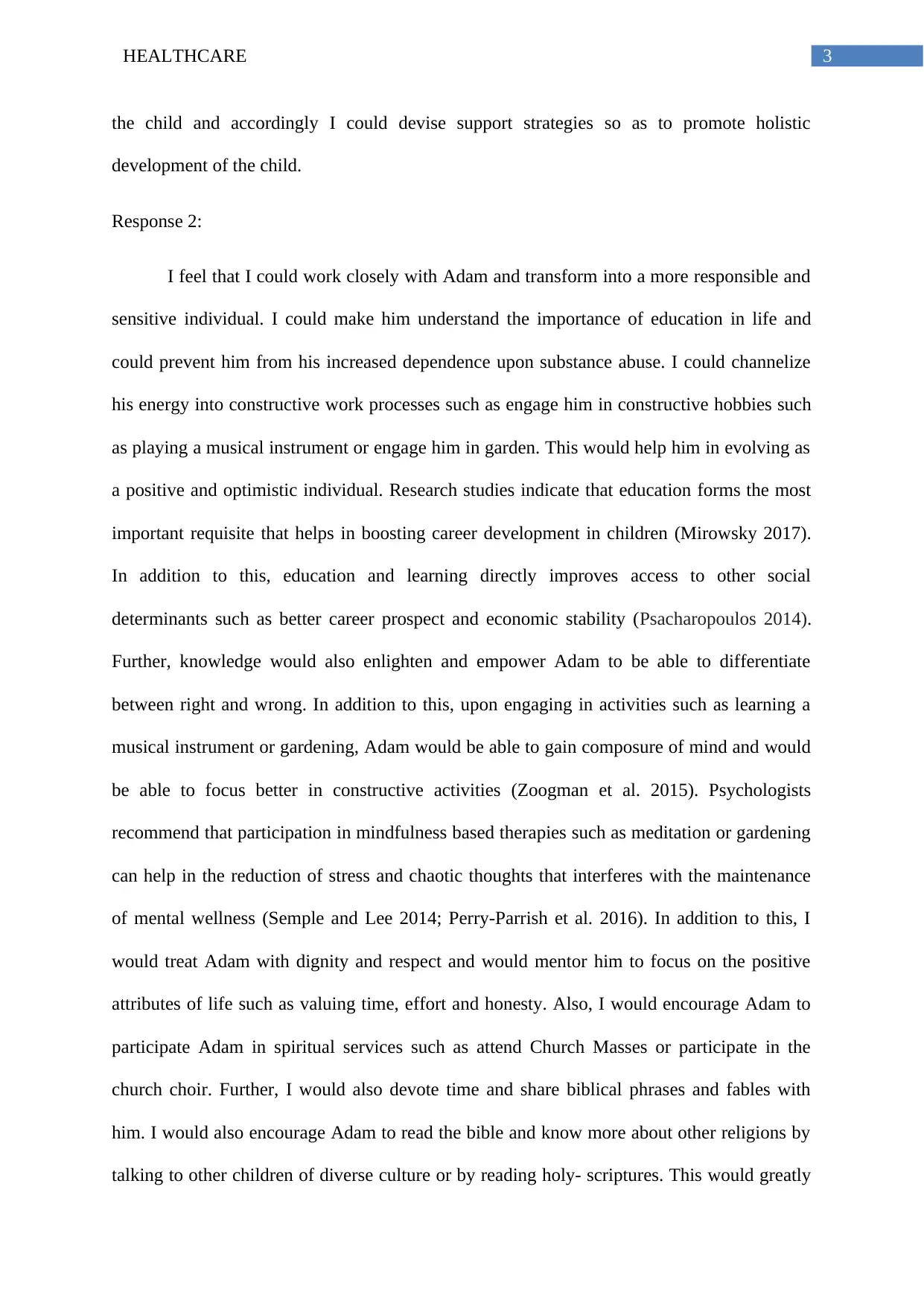
3HEALTHCARE
the child and accordingly I could devise support strategies so as to promote holistic
development of the child.
Response 2:
I feel that I could work closely with Adam and transform into a more responsible and
sensitive individual. I could make him understand the importance of education in life and
could prevent him from his increased dependence upon substance abuse. I could channelize
his energy into constructive work processes such as engage him in constructive hobbies such
as playing a musical instrument or engage him in garden. This would help him in evolving as
a positive and optimistic individual. Research studies indicate that education forms the most
important requisite that helps in boosting career development in children (Mirowsky 2017).
In addition to this, education and learning directly improves access to other social
determinants such as better career prospect and economic stability (Psacharopoulos 2014).
Further, knowledge would also enlighten and empower Adam to be able to differentiate
between right and wrong. In addition to this, upon engaging in activities such as learning a
musical instrument or gardening, Adam would be able to gain composure of mind and would
be able to focus better in constructive activities (Zoogman et al. 2015). Psychologists
recommend that participation in mindfulness based therapies such as meditation or gardening
can help in the reduction of stress and chaotic thoughts that interferes with the maintenance
of mental wellness (Semple and Lee 2014; Perry-Parrish et al. 2016). In addition to this, I
would treat Adam with dignity and respect and would mentor him to focus on the positive
attributes of life such as valuing time, effort and honesty. Also, I would encourage Adam to
participate Adam in spiritual services such as attend Church Masses or participate in the
church choir. Further, I would also devote time and share biblical phrases and fables with
him. I would also encourage Adam to read the bible and know more about other religions by
talking to other children of diverse culture or by reading holy- scriptures. This would greatly
the child and accordingly I could devise support strategies so as to promote holistic
development of the child.
Response 2:
I feel that I could work closely with Adam and transform into a more responsible and
sensitive individual. I could make him understand the importance of education in life and
could prevent him from his increased dependence upon substance abuse. I could channelize
his energy into constructive work processes such as engage him in constructive hobbies such
as playing a musical instrument or engage him in garden. This would help him in evolving as
a positive and optimistic individual. Research studies indicate that education forms the most
important requisite that helps in boosting career development in children (Mirowsky 2017).
In addition to this, education and learning directly improves access to other social
determinants such as better career prospect and economic stability (Psacharopoulos 2014).
Further, knowledge would also enlighten and empower Adam to be able to differentiate
between right and wrong. In addition to this, upon engaging in activities such as learning a
musical instrument or gardening, Adam would be able to gain composure of mind and would
be able to focus better in constructive activities (Zoogman et al. 2015). Psychologists
recommend that participation in mindfulness based therapies such as meditation or gardening
can help in the reduction of stress and chaotic thoughts that interferes with the maintenance
of mental wellness (Semple and Lee 2014; Perry-Parrish et al. 2016). In addition to this, I
would treat Adam with dignity and respect and would mentor him to focus on the positive
attributes of life such as valuing time, effort and honesty. Also, I would encourage Adam to
participate Adam in spiritual services such as attend Church Masses or participate in the
church choir. Further, I would also devote time and share biblical phrases and fables with
him. I would also encourage Adam to read the bible and know more about other religions by
talking to other children of diverse culture or by reading holy- scriptures. This would greatly
Paraphrase This Document
Need a fresh take? Get an instant paraphrase of this document with our AI Paraphraser
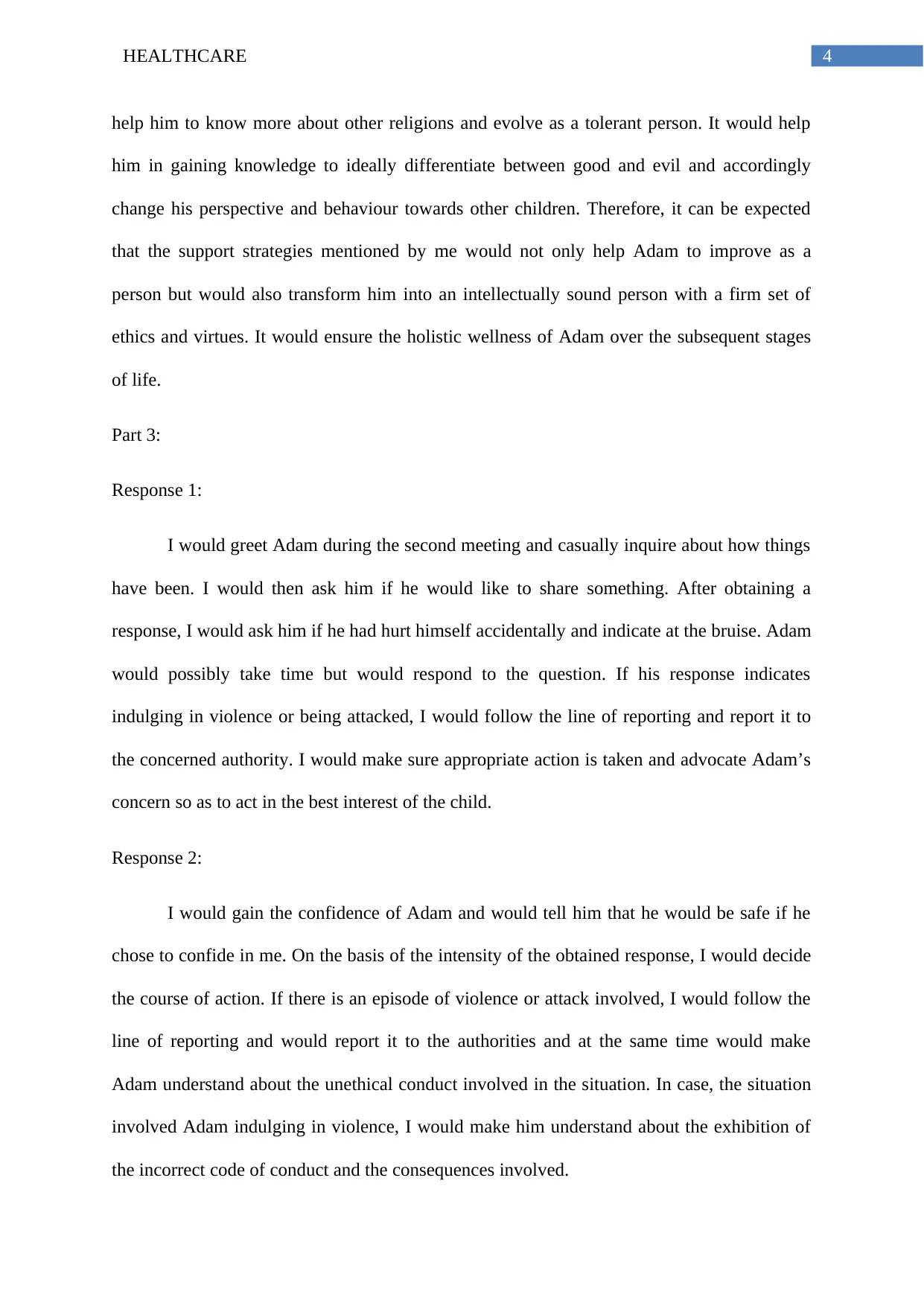
4HEALTHCARE
help him to know more about other religions and evolve as a tolerant person. It would help
him in gaining knowledge to ideally differentiate between good and evil and accordingly
change his perspective and behaviour towards other children. Therefore, it can be expected
that the support strategies mentioned by me would not only help Adam to improve as a
person but would also transform him into an intellectually sound person with a firm set of
ethics and virtues. It would ensure the holistic wellness of Adam over the subsequent stages
of life.
Part 3:
Response 1:
I would greet Adam during the second meeting and casually inquire about how things
have been. I would then ask him if he would like to share something. After obtaining a
response, I would ask him if he had hurt himself accidentally and indicate at the bruise. Adam
would possibly take time but would respond to the question. If his response indicates
indulging in violence or being attacked, I would follow the line of reporting and report it to
the concerned authority. I would make sure appropriate action is taken and advocate Adam’s
concern so as to act in the best interest of the child.
Response 2:
I would gain the confidence of Adam and would tell him that he would be safe if he
chose to confide in me. On the basis of the intensity of the obtained response, I would decide
the course of action. If there is an episode of violence or attack involved, I would follow the
line of reporting and would report it to the authorities and at the same time would make
Adam understand about the unethical conduct involved in the situation. In case, the situation
involved Adam indulging in violence, I would make him understand about the exhibition of
the incorrect code of conduct and the consequences involved.
help him to know more about other religions and evolve as a tolerant person. It would help
him in gaining knowledge to ideally differentiate between good and evil and accordingly
change his perspective and behaviour towards other children. Therefore, it can be expected
that the support strategies mentioned by me would not only help Adam to improve as a
person but would also transform him into an intellectually sound person with a firm set of
ethics and virtues. It would ensure the holistic wellness of Adam over the subsequent stages
of life.
Part 3:
Response 1:
I would greet Adam during the second meeting and casually inquire about how things
have been. I would then ask him if he would like to share something. After obtaining a
response, I would ask him if he had hurt himself accidentally and indicate at the bruise. Adam
would possibly take time but would respond to the question. If his response indicates
indulging in violence or being attacked, I would follow the line of reporting and report it to
the concerned authority. I would make sure appropriate action is taken and advocate Adam’s
concern so as to act in the best interest of the child.
Response 2:
I would gain the confidence of Adam and would tell him that he would be safe if he
chose to confide in me. On the basis of the intensity of the obtained response, I would decide
the course of action. If there is an episode of violence or attack involved, I would follow the
line of reporting and would report it to the authorities and at the same time would make
Adam understand about the unethical conduct involved in the situation. In case, the situation
involved Adam indulging in violence, I would make him understand about the exhibition of
the incorrect code of conduct and the consequences involved.

5HEALTHCARE
⊘ This is a preview!⊘
Do you want full access?
Subscribe today to unlock all pages.

Trusted by 1+ million students worldwide
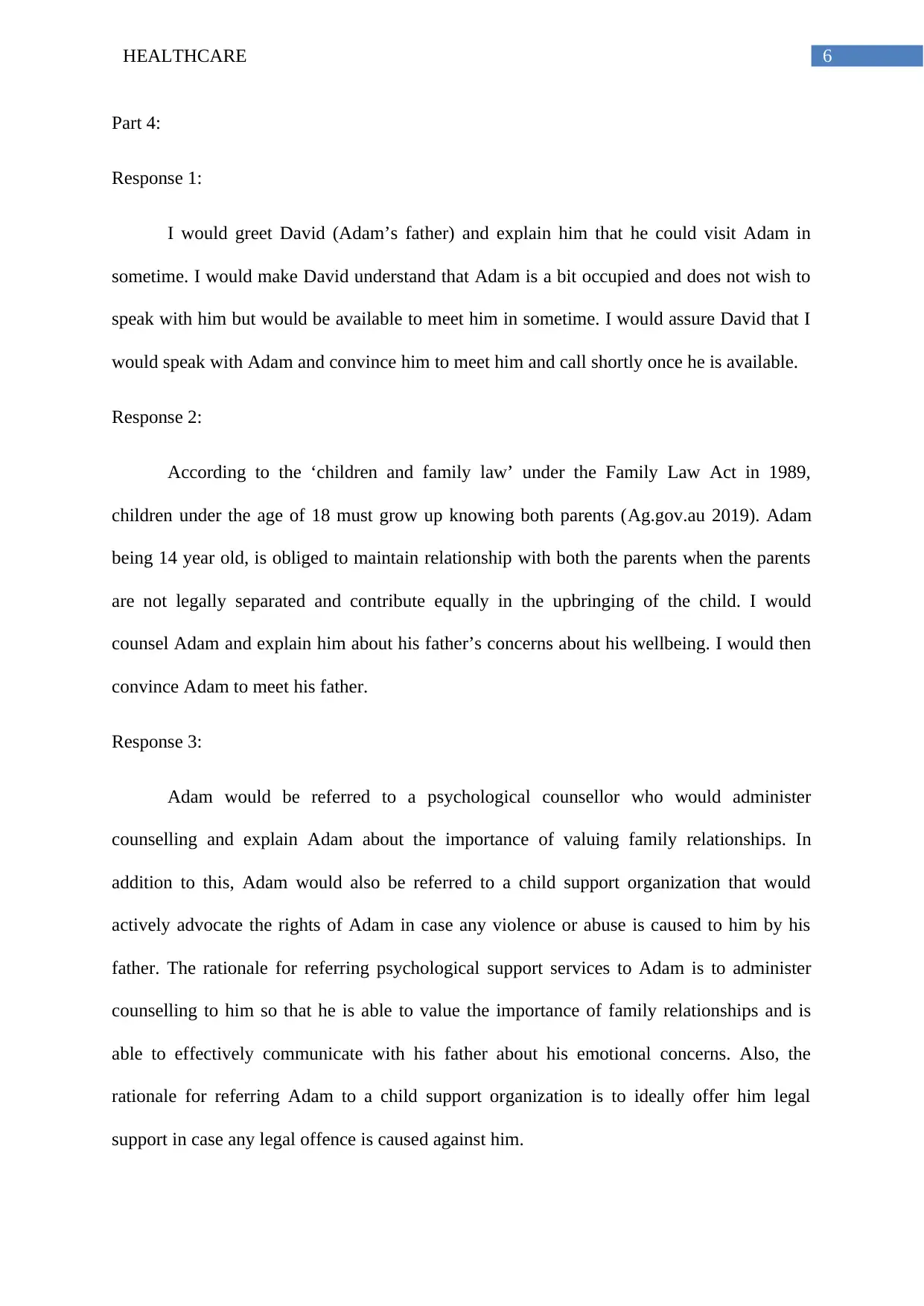
6HEALTHCARE
Part 4:
Response 1:
I would greet David (Adam’s father) and explain him that he could visit Adam in
sometime. I would make David understand that Adam is a bit occupied and does not wish to
speak with him but would be available to meet him in sometime. I would assure David that I
would speak with Adam and convince him to meet him and call shortly once he is available.
Response 2:
According to the ‘children and family law’ under the Family Law Act in 1989,
children under the age of 18 must grow up knowing both parents (Ag.gov.au 2019). Adam
being 14 year old, is obliged to maintain relationship with both the parents when the parents
are not legally separated and contribute equally in the upbringing of the child. I would
counsel Adam and explain him about his father’s concerns about his wellbeing. I would then
convince Adam to meet his father.
Response 3:
Adam would be referred to a psychological counsellor who would administer
counselling and explain Adam about the importance of valuing family relationships. In
addition to this, Adam would also be referred to a child support organization that would
actively advocate the rights of Adam in case any violence or abuse is caused to him by his
father. The rationale for referring psychological support services to Adam is to administer
counselling to him so that he is able to value the importance of family relationships and is
able to effectively communicate with his father about his emotional concerns. Also, the
rationale for referring Adam to a child support organization is to ideally offer him legal
support in case any legal offence is caused against him.
Part 4:
Response 1:
I would greet David (Adam’s father) and explain him that he could visit Adam in
sometime. I would make David understand that Adam is a bit occupied and does not wish to
speak with him but would be available to meet him in sometime. I would assure David that I
would speak with Adam and convince him to meet him and call shortly once he is available.
Response 2:
According to the ‘children and family law’ under the Family Law Act in 1989,
children under the age of 18 must grow up knowing both parents (Ag.gov.au 2019). Adam
being 14 year old, is obliged to maintain relationship with both the parents when the parents
are not legally separated and contribute equally in the upbringing of the child. I would
counsel Adam and explain him about his father’s concerns about his wellbeing. I would then
convince Adam to meet his father.
Response 3:
Adam would be referred to a psychological counsellor who would administer
counselling and explain Adam about the importance of valuing family relationships. In
addition to this, Adam would also be referred to a child support organization that would
actively advocate the rights of Adam in case any violence or abuse is caused to him by his
father. The rationale for referring psychological support services to Adam is to administer
counselling to him so that he is able to value the importance of family relationships and is
able to effectively communicate with his father about his emotional concerns. Also, the
rationale for referring Adam to a child support organization is to ideally offer him legal
support in case any legal offence is caused against him.
Paraphrase This Document
Need a fresh take? Get an instant paraphrase of this document with our AI Paraphraser
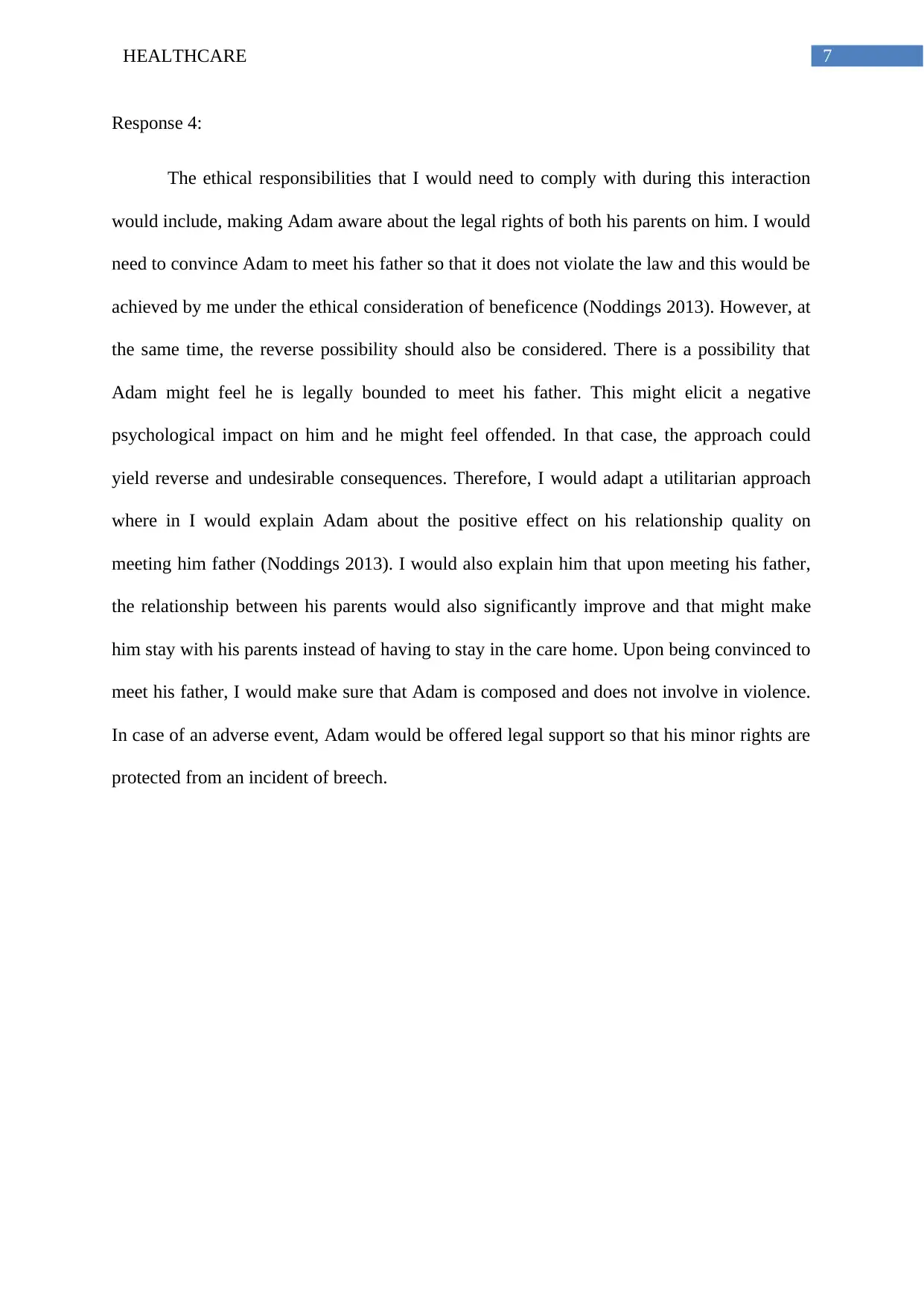
7HEALTHCARE
Response 4:
The ethical responsibilities that I would need to comply with during this interaction
would include, making Adam aware about the legal rights of both his parents on him. I would
need to convince Adam to meet his father so that it does not violate the law and this would be
achieved by me under the ethical consideration of beneficence (Noddings 2013). However, at
the same time, the reverse possibility should also be considered. There is a possibility that
Adam might feel he is legally bounded to meet his father. This might elicit a negative
psychological impact on him and he might feel offended. In that case, the approach could
yield reverse and undesirable consequences. Therefore, I would adapt a utilitarian approach
where in I would explain Adam about the positive effect on his relationship quality on
meeting him father (Noddings 2013). I would also explain him that upon meeting his father,
the relationship between his parents would also significantly improve and that might make
him stay with his parents instead of having to stay in the care home. Upon being convinced to
meet his father, I would make sure that Adam is composed and does not involve in violence.
In case of an adverse event, Adam would be offered legal support so that his minor rights are
protected from an incident of breech.
Response 4:
The ethical responsibilities that I would need to comply with during this interaction
would include, making Adam aware about the legal rights of both his parents on him. I would
need to convince Adam to meet his father so that it does not violate the law and this would be
achieved by me under the ethical consideration of beneficence (Noddings 2013). However, at
the same time, the reverse possibility should also be considered. There is a possibility that
Adam might feel he is legally bounded to meet his father. This might elicit a negative
psychological impact on him and he might feel offended. In that case, the approach could
yield reverse and undesirable consequences. Therefore, I would adapt a utilitarian approach
where in I would explain Adam about the positive effect on his relationship quality on
meeting him father (Noddings 2013). I would also explain him that upon meeting his father,
the relationship between his parents would also significantly improve and that might make
him stay with his parents instead of having to stay in the care home. Upon being convinced to
meet his father, I would make sure that Adam is composed and does not involve in violence.
In case of an adverse event, Adam would be offered legal support so that his minor rights are
protected from an incident of breech.
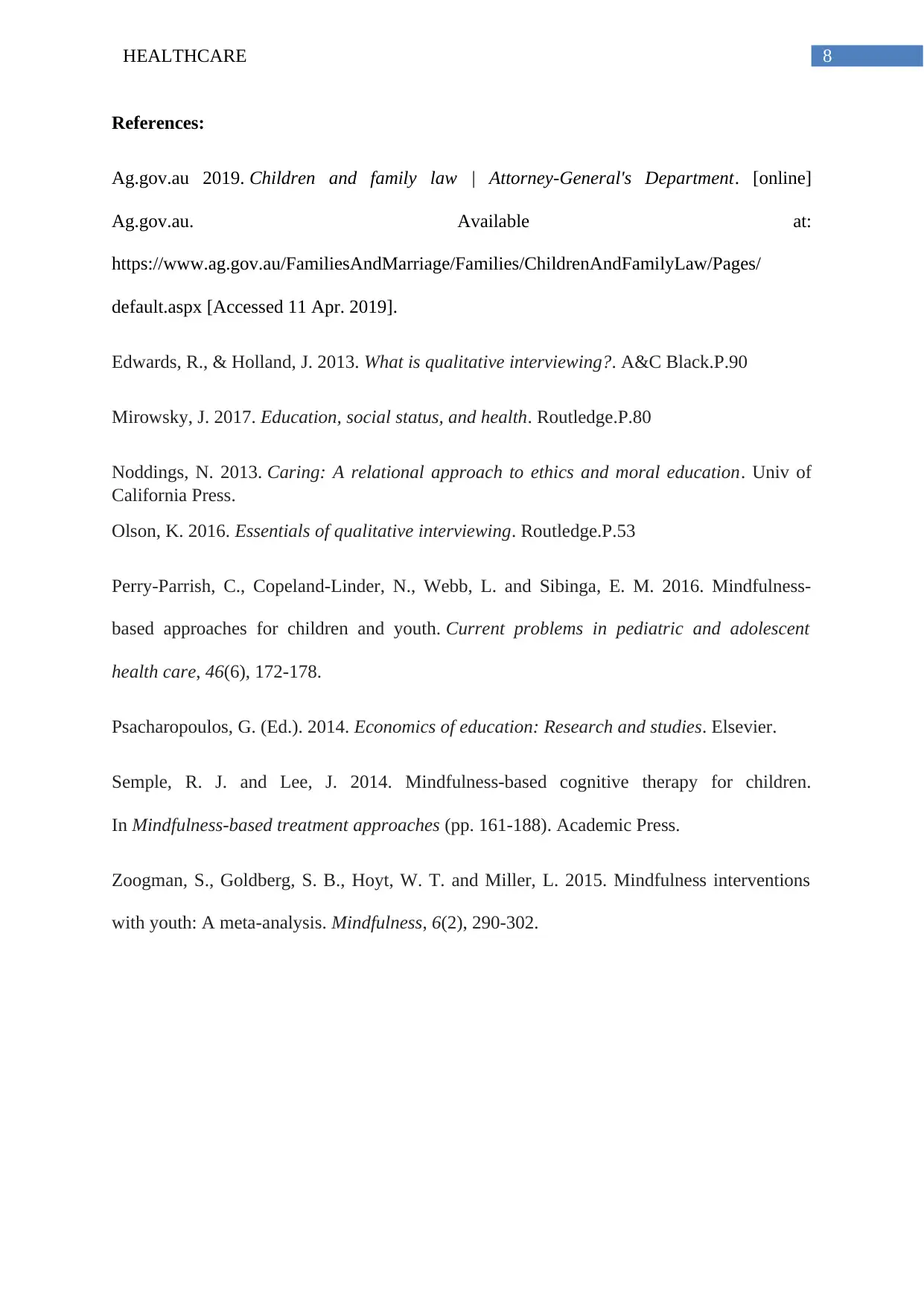
8HEALTHCARE
References:
Ag.gov.au 2019. Children and family law | Attorney-General's Department. [online]
Ag.gov.au. Available at:
https://www.ag.gov.au/FamiliesAndMarriage/Families/ChildrenAndFamilyLaw/Pages/
default.aspx [Accessed 11 Apr. 2019].
Edwards, R., & Holland, J. 2013. What is qualitative interviewing?. A&C Black.P.90
Mirowsky, J. 2017. Education, social status, and health. Routledge.P.80
Noddings, N. 2013. Caring: A relational approach to ethics and moral education. Univ of
California Press.
Olson, K. 2016. Essentials of qualitative interviewing. Routledge.P.53
Perry-Parrish, C., Copeland-Linder, N., Webb, L. and Sibinga, E. M. 2016. Mindfulness-
based approaches for children and youth. Current problems in pediatric and adolescent
health care, 46(6), 172-178.
Psacharopoulos, G. (Ed.). 2014. Economics of education: Research and studies. Elsevier.
Semple, R. J. and Lee, J. 2014. Mindfulness-based cognitive therapy for children.
In Mindfulness-based treatment approaches (pp. 161-188). Academic Press.
Zoogman, S., Goldberg, S. B., Hoyt, W. T. and Miller, L. 2015. Mindfulness interventions
with youth: A meta-analysis. Mindfulness, 6(2), 290-302.
References:
Ag.gov.au 2019. Children and family law | Attorney-General's Department. [online]
Ag.gov.au. Available at:
https://www.ag.gov.au/FamiliesAndMarriage/Families/ChildrenAndFamilyLaw/Pages/
default.aspx [Accessed 11 Apr. 2019].
Edwards, R., & Holland, J. 2013. What is qualitative interviewing?. A&C Black.P.90
Mirowsky, J. 2017. Education, social status, and health. Routledge.P.80
Noddings, N. 2013. Caring: A relational approach to ethics and moral education. Univ of
California Press.
Olson, K. 2016. Essentials of qualitative interviewing. Routledge.P.53
Perry-Parrish, C., Copeland-Linder, N., Webb, L. and Sibinga, E. M. 2016. Mindfulness-
based approaches for children and youth. Current problems in pediatric and adolescent
health care, 46(6), 172-178.
Psacharopoulos, G. (Ed.). 2014. Economics of education: Research and studies. Elsevier.
Semple, R. J. and Lee, J. 2014. Mindfulness-based cognitive therapy for children.
In Mindfulness-based treatment approaches (pp. 161-188). Academic Press.
Zoogman, S., Goldberg, S. B., Hoyt, W. T. and Miller, L. 2015. Mindfulness interventions
with youth: A meta-analysis. Mindfulness, 6(2), 290-302.
⊘ This is a preview!⊘
Do you want full access?
Subscribe today to unlock all pages.

Trusted by 1+ million students worldwide
1 out of 9
Related Documents
Your All-in-One AI-Powered Toolkit for Academic Success.
+13062052269
info@desklib.com
Available 24*7 on WhatsApp / Email
![[object Object]](/_next/static/media/star-bottom.7253800d.svg)
Unlock your academic potential
Copyright © 2020–2025 A2Z Services. All Rights Reserved. Developed and managed by ZUCOL.





